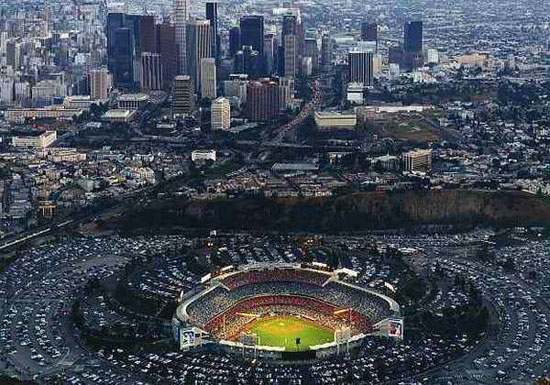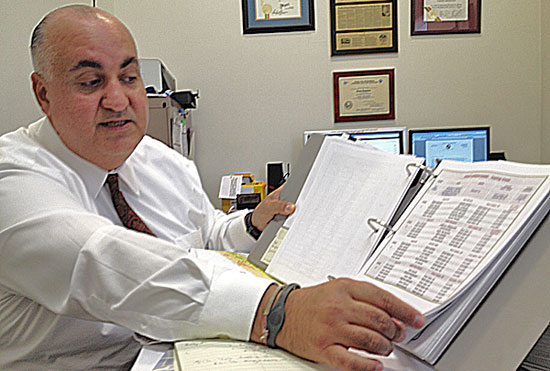The buses of summer
March 27, 2014

With millions of fans expected to pack Dodger Stadium, traffic planners are swinging for the fences.
Aram Sahakian doesn’t begrudge the rejuvenated Los Angeles Dodgers their success. But Blue Heaven can mean one helluva headache on his playing field—the city’s streets.
For Sahakian, who oversees special traffic operations for the Los Angeles Department of Transportation, it’s batter up every time there’s a major traffic event in the city. Now, with the L.A. Marathon and the Academy Awards behind him, he’s getting ready for the rush-hour throngs that will wend their way into Dodger Stadium beginning next week.
Although game-day traffic is always heavy around Chavez Ravine, it was particularly challenging last year. Attendance soared to its highest level in seven years—nearly a million above its 2011 low point, when San Francisco Giants fan Brian Stow was brutally beaten in a stadium parking lot in the season’s early weeks. With new owners and a powerhouse lineup that notched an epic winning streak, the Dodgers became one of the hottest tickets in town virtually overnight.
And this year could be even bigger. Sahakian says he’s been told that all but 15 of the team’s 81 home games already have sold at least 40,000 tickets, with tens of thousands more expected to be snapped up as the season progresses.
If baseball is a sport of statistics—batting averages, slugging percentages, RBIs, ERAs and the like—then so, too, is the traffic game. And Sahakian is a student of the stats. He knows, for example, that when the number of cars per hour, per lane, exceeds 1,200, “speed starts slowing down and you get into a gridlock, standstill type of situation.” That string of 40,000-ticket games for this season? He says they’ll easily push the streets beyond their free-flowing capacity, requiring a game plan every bit as nuanced as the one Dodgers skipper Don Mattingly will create for his crew.
To ease the coming crunch, Metro and city transportation officials are urging fans to save themselves some stress—and do their fellow motorists a favor—by ride-sharing or hopping aboard the Dodger Stadium Express bus, which leaves Union Station every 5 to 10 minutes, beginning 90 minutes before the game and continuing through the 3rd inning. The ride is free for ticket holders.
The express buses have been running for four seasons, but last year they scored their highest ridership yet, jumping from 136,000 passengers to 186,000. “Obviously,” Sahakian says, “we want to double that, if not triple it, this year.”
Last year, the route included for the first time a 1.5-mile dedicated bus lane along Sunset Boulevard. If more people continue to ride the express, Sahakian says, then traffic should ease for commuters struggling to get home along Sunset’s main lanes, which frequently were bumper to bumper from downtown to the stadium.
This year, Sahakian says, he also was determined to fix what he saw as a traffic and safety issue—the use of orange cones to keep vehicles out of the newly-designated Dodger express bus lane. Not only were buses “knocking cones all over the place,” he says, but transportation workers were “putting themselves in harm’s way” by setting them up with cars whizzing past. The cones also made it difficult, he says, for police to pull violators out of the bus lanes without a nearby side street or a break in the cone line.
So instead of the cones, Sahakian says, what he really wanted was a stripe on the pavement—“and I said I wanted it immediately.” And that, in turn, would end up giving L.A. cyclists a much-needed gift in the process.
Sahakian’s inquiries led to the discovery that the city’s bicycle master plan called for a lane to be painted along that same stretch of Sunset Boulevard at some point in the future—a time frame that was accelerated to create a combination year-round bus and bike lane during peak traffic hours.
The Dodger Stadium Express buses, however, are just one facet of a broad push to ease ballpark congestion. Among other things, a bus/bike lane has now also been painted on eastbound Sunset Boulevard to facilitate the post-game flow. What’s more, another stadium entrance, at Scott Street, will be opened to help reduce congestion, despite complaints from Echo Park residents who worry that the increased traffic will bring problems to their neighborhood.
Sahakian acknowledges that reopening the Scott Avenue gate “is a very sensitive issue.” But he insists that the city is working hard to avert problems with a plan to route vehicles around residential neighborhoods, increase the number of traffic control officers and create a locals-only preferential parking district.
But no matter how many traffic mitigation measures are undertaken, Sahakian says, there’s really nothing that can be done about the biggest one, a truism of L.A. fandom. “It’s not a secret that Angelenos,” he says knowingly, “don’t plan on getting to any sporting event early enough to avoid traffic.”
Posted 3/27/14













 405 bridge work causes a stink
405 bridge work causes a stink
